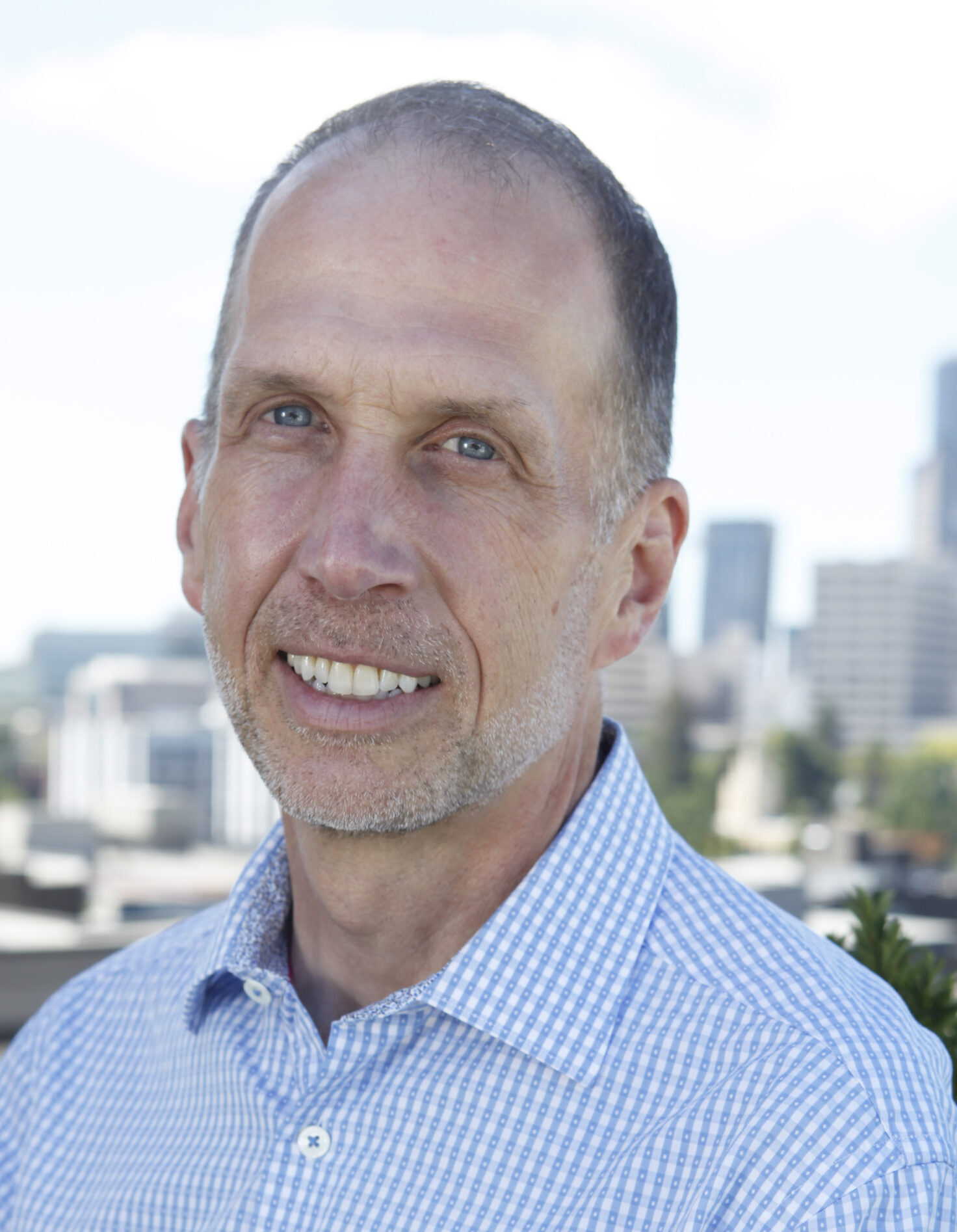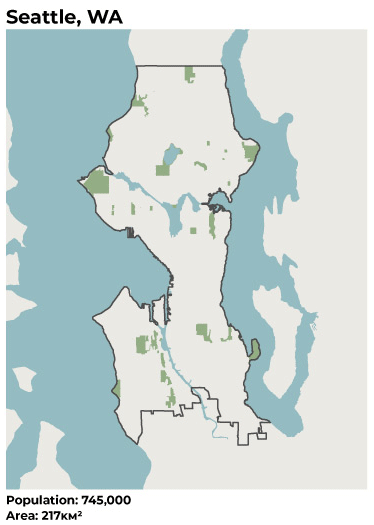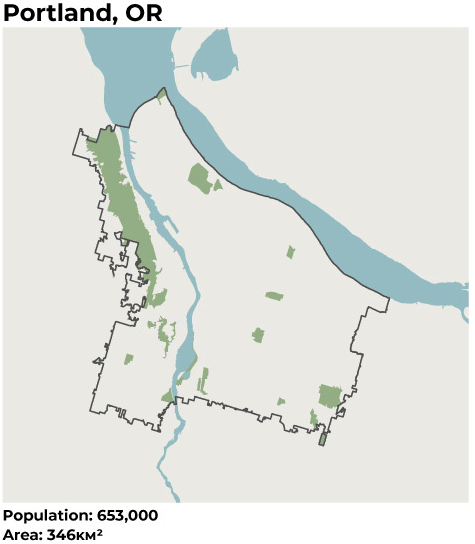Matthew Gardner, the chief economist at Seattle’s Windermere Real Estate, earlier this year digitally superimposed a map of Paris atop a map of Seattle for a talk he gave about how outdated single-detached zoning is. It’s a familiar theme for Sightline readers who have been tracking our arguments about housing shortages and climate change. The image spread at Twitter speed through Seattle’s small world of housing and climate hawks and then as quickly faded, replaced by the next meme and quip.
But I kept thinking about it.
What’s eye-opening about the Paris-on-Seattle map is that Paris—the City of Light, the modern birthplace of democracy, the cradle of the climate treaty that we hope may yet save us, the embodiment of urbane living, perhaps the closest thing the world currently has to an emblem for civilization itself—is tiny. You could set it atop Seattle’s north end, beyond the ship canal, and very little would splash down outside of the city—especially if you snipped off Paris’s wings, which are vast parks. Stacking Paris atop north Seattle would not even ruffle a feather of downtown, Amazon’s South Lake Union haunts, or the Starbucks and Boeing neighborhoods farther south. Yet Paris holds, in that limited space, three times as many people as all of Seattle.
Mr. Gardner’s rendition was quickly done, so Sightline redrew the map and gussied it up.
Sightline did the same for Cascadia’s two other big cities, Vancouver, BC, and Portland, overlaying Barcelona and Vienna, respectively.
Why these cities? For Cascadia’s big three, Vienna, Paris, and Barcelona are worth emulating. First, they are affordable, at least relatively speaking. International comparisons of housing affordability, as opposed to housing prices, are notoriously difficult. Affordability is a function of prices and incomes, and incomes vary widely. Plus every home is different, and comprehensive data are hard to come by. Still, four outfits have made respectable attempts: Demographia, the Economist, and the real-estate companies Knight-Frank and Point2Homes. Collectively, their surveys show that Vancouver, BC, is egregiously expensive, and that Portland and Seattle are also painfully pricey—no surprise! Seattle is now the fourth most expensive US city for renters.
In contrast, Paris falls in the second most affordable group of cities in the Knight-Frank study. Vienna is a standout of affordability through housing abundance, as I have detailed. And Barcelona, included in the Economist’s study, is, if not cheap, at least less expensive than most of the global gems the magazine studied.
Second, and largely explaining the first, these three cities have built enough homes to welcome substantially more people on each acre than Cascadia’s cities: Paris is almost six times as densely settled as Seattle. Barcelona is three times as dense as Vancouver. And Vienna is more than twice as dense as Portland, despite the fact that the Austrian capital’s boundaries encompass vast amounts of parks and open space—almost half the city, by one estimate. (Incidentally, Vancouver is almost three times denser than Portland and 60 percent denser than Seattle, further strengthening the case that international cities are worth emulating in the United States.)
Third, Vienna, Paris, and Barcelona are greener. Compact, populous cities save so much energy by sharing walls, shortening trips, and shedding cars that they are to urban planning what windmills are to the electric grid: indispensable climate protectors. As the concentration of people rises, greenhouse gas emissions decline precipitously: for every doubling of density, emissions per household drop by almost half from transportation and by more than a third from home energy use.
Fourth, they are, as cities, wonders to behold: meccas for quality of life. Vienna, like Vancouver, has recently dominated more than one of the rankings for the world’s most livable city. And Barcelona, Paris, and Vienna (again, like Vancouver) are all among the world’s most beautiful cities, if Condé Nast Traveler can be believed.
Vienna, Paris, and Barcelona aren’t the only cities I could have picked to make my point (though others would not have made such a pleasing allusion to the 2008 Woody Allen film). I could have picked Singapore, Kyoto, Buenos Aires, or Phnom Penh, to say nothing of planning-school favorites in northern Europe such as Amsterdam or Copenhagen. Or a dozen other cities.
Cascadia’s cities, like all of North America’s cities, remain—for all the arm-flailing that locals do about neighborhood character and traffic—sparsely peopled places. Uncrowded in the extreme. And until a governing majority of us Cascadians feel that fact in our guts, we are likely to make only halting progress on our housing shortage and our transition to zero-carbon cities.
When enough of us realize that the future we say we want looks different than the cities we live in, when we realize that to build communities that manifest the values we express so fervently and aspire to so earnestly—sustainable, equitable, welcoming, tolerant, democratic, community-oriented, opportunity-rich, beautiful—we will be able to make our cities look more like Vienna, Paris, and Barcelona.
And less like the north end of Seattle, most of it frozen in single-detached amber since the 1960s, astronomically overpriced for lack of multi-family homes, and almost big enough to hold the entire City of Light.

Vienna by Miroslav Petrasko used under CC BY-NC-ND 2.0
Appendix
Side-by-side editions of Seattle-Paris, Barcelona-Vancouver, and Vienna-Portland.
Maps of the cities, showing the park area in each, are here: Barcelona, Paris, Portland, Seattle, Vancouver, and Vienna.
Thanks to Matt Stevenson of CoreGIS, who drew the maps for accuracy, and Devin Porter, who designed them for presentation.











Malcolm Srake
There’s a big-ass elephant in your high density living room, sad to say.
Sincecyou failed to mention this, I will. Every time we figure out a way to reduce per capita greenhouse gas emission, the entire reduction is eliminated when the actual population grows by this same amount.
Tim DuBois
There is a big-ass elephant in your argument. If a population is growing in an environmentally sustainable place it means it is either reducing growth in an environmentally bad place or at least keep it from growing there. What climate change is concerned about is global carbon emissions, not how much emissions come from a single neighborhood in Seattle. So it is entirely possible and in fact probable that three things can all be true at once. Per capita carbon emissions can be reduced in a city, total carbon emissions can increase in that city, and global carbon emissions are reduced. A place becomes denser, people like that (if prices are an indicator), so they leave energy-intensive suburban lifestyle.
A point worth making: zoning is not a tool to regulate global population growth. That is a separate and very important discussion to be had.
DC
That’s not how that works…at all. You changed your unit of measurement halfway through that sentence. Per Capita vs. total population.
Fran Korten
Really useful article Alan. It looks like Vienna, along with Paris (don’t know about Barcelona) have height limits to their buildings, right? It’s that part of what makes them feel livable?
BK
I don’t know the legal details, but I can attest that vast swathes of Barcelona are six stories (much like Paris). There are taller buildings, but they seem relatively rare. (Was just there this spring. And +1 to every comment, Alan, about being a livable city. Would be great to see a future article about transportation. My impression: Barcelona has some very large arterials, but ~always paired with bike/scooter lanes. And lots of areas where cars are an option, but basically only at walking speed. It was a real pleasure to be a pedestrian.)
Fran Korten
Thanks. Yes, a 6 story limit seems to make a city feel more human scale. And no big shadows over the parks, like what Central Park is now experiencing with all the ego-driven towers lining its borders.
Tim DuBois
There is a limit in Barcelona but it is pretty high. Nothing can be taller than the Segrada Familia. But a height limit is not the success story. Those heights I agree are the best for comfort and can still provide the necessary density just by having narrower streets, but Paris needs the places outside the historic downtown that allow much taller heights to accommodate growth in population.
Anna Porter
I think the issue lies here, Tim: “the future we say we want”…I don’t believe that a large portion of Seattle city homeowners really care more about values like sustainable, equitable, welcoming, etc… They are more concerned with making money on their investment and worry too much about what happens to the value of their property if properties around them start sprouting multi-family housing. 🙁
DC
But a 6 story limit in lieu of single family neighborhoods. That’s an important detail. I’d also note that “single family neighborhoods” are really anything but at this point in cities like Seattle. Half of the houses are comprised of 7 20-somethings packed into a 5bd house. Or two low income families sharing a house. Essentially all you get when you try to “preserve” the detached house “single family” neighborhoods is worse quality of life for all.
Ann B Daigle
Great article. We always overlay cities on one another to show clients the scale (and how much land they’re wasting). Yay to the 6-story walkup!
Joseph Enright
Excellent article with some important points. just one thing to consider. Many of those cities mentioned Paris in particular are surrounded by massive suburbs where much of the industry and commerce takes place where you will find office parks and shopping centers just like the USA. needless to say they are automobile intensive. Portland OR grew by annexing suburbs that accounts in part for its relative low density. in order to make informed comparisons I would suggest utilizing the skills of a trained geographer
RDPence
Yes, it’s truly sad that Seattle developed the way it did, that our pioneers chose to develop neighborhoods of SF homes instead of 6-story walk-ups. Perhaps the people of that era were just ignorant of the wonderfulness of life in Paris, Barcelona, etc. and were thus unable to emulate those superior cities. Or perhaps the people of Seattle just preferred SF homes over having to climb stairs to get to their front door.
A fun little game, such comparisons. I would like to see Manhattan overlaid on Seattle, see how that fits. But Seattle is what it is, and we have no magic wand to wave and recreate it in some superior image.
Cam
I think actually there is a magic wand: ending single-family zoning.
It wouldn’t happen overnight but this would set into motion a slow densification process that will probably end up with Seattle looking something like Paris in 1,000 years or so.
RDPence
Great response, but somehow I don’t think today’s urbanists would be content to wait 1000 years ~ I think their time horizon is closer to 20. On their schedule, Seattle would first need its own Baron Haussmann to demolish enough of the old city, to allow its reconstruction in their superior vision.
Cam
I pretty much agree with all your points, but calling Paris and Barcelona “affordable” made me LOL.
The Economist study you cite on Barcelona ends in 2009, a year in which I was renting a 2-bedroom apartment in Eastlake (Seattle) for $900. I’m not sure about Paris, but every time I’ve visited it seemed extremely expensive and the average wages there are lower than in Seattle.
That being said, a lot of Barcelona’s and Paris’ affordability problems are driven by tourism which probably isn’t an issue that Seattle is going to experience to the same degree that Paris and Barcelona experience.
Sherri A Schultz
I propose that Sightline partner with Rick Steves for a “Sustainable Europe Through the Back Door” tour, so we can go see for ourselves. I’m in 🙂
Thomas I. Ellis
An insightful article, and having been to both Vienna and Paris (but not yet Barcelona) I agree entirely with the author’s assessment of their superior livability and intelligent design for density and civility, in contrast to US cities.
The challenge is that we are stuck, now, with the single-family, auto-dependent, carbon-spewing suburban sprawl from the postwar era, that continues to this day, eating up more and more arable land and sensitive habitats in adjoining rural areas–building out, rather than up–simply because few people are willing to give up their treasured (and isolated) McMansions for multifamily units. As long as petroleum is subsidized, and hence affordable, this wasteful, carbon-spewing trend is likely to continue.
So the challenge is how to retrofit the existing suburbs in preparation for a postcarbon economy and culture. The answers, of course, are incredibly complex and site-specific, but in my view, the common theme of such answers can be summed up in a bumper-sticker-sized slogan: “Grow Gardens; Grow Community; Grow Awareness.” These three injunctions mutually support each other: (1) By developing the skills to transform monocultural lawns into edible organic gardens, we increase our self-reliance and heal the topsoil; (2) By sharing those skills–and our surplus–with our neighbors, we strengthen community (and push back against suburban isolation and alienation); and (3) through both processes–learning regenerative gardening and meeting and talking with our neighbors–we cultivate greater awareness of what needs to be done, and how we are doing it, to increase the liveability and self-reliance of our communities; reduce our dependence on fossil fuels, corporate consumerism, and agribusiness; and thereby transform and revitalize our dying and dysfunctional culture and (possibly) heal our dying planet as well!
RDPence
Yes, by all means ~ come out to the suburbs and lecture the people there about how they ought to live, how they should set aside their values and adopt your superior ones. See how far you get.
Mary Holscher
Excellent article. The information and images that helps us compare Seattle to other cities we admire and are much more dense is so useful. Thank you!
Darlene Urban Garrett
I believe that the European cities are not taking up so much usable space with massive parking facilities, and actual streets widths are about half the the size of an American Street. Not sure the comparison is relevant in that our land mass per city is greater because we actually have much more space to development in, on, and around. Issues of sustainability begins with the quality of the architecture. Our buildings last, on the positive side, 200 years, European buildings are sustained for 100’s of years.